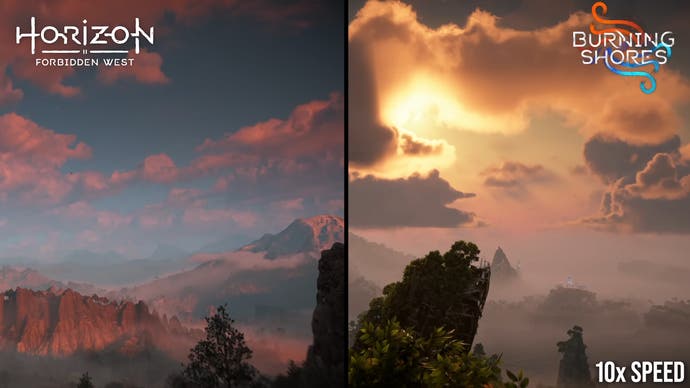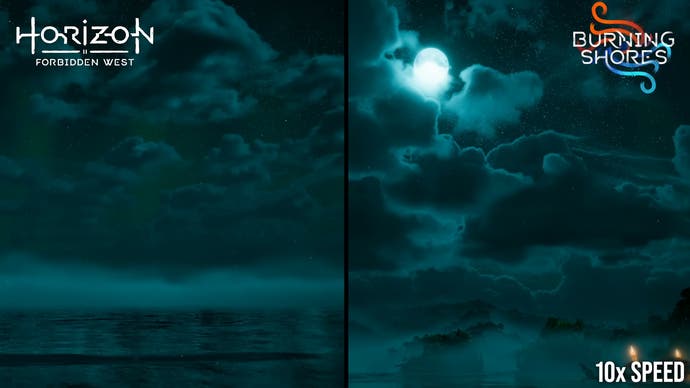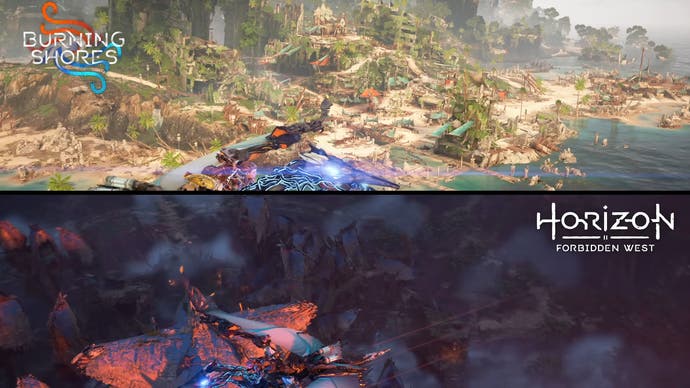Horizon Forbidden West: Burning Shores is a visual masterclass
A new world, built to maximise in-flight beauty with stunning clouds, terrain and towns.
Horizon Forbidden West is one of the best-looking games of this generation - in fact, it won 'best graphics' in our awards last year. With abundant foliage, beautiful lighting, and stunning environmental detail, Guerilla Games' open world sequel was seriously impressive - but the Burning Shores DLC looks poised to be even more spectacular. A reworked cloud rendering system alongside PS5 exclusivity promises graphical enhancements above and beyond the base game experience. So how does Burning Shores raise the visual bar? And does the increased fidelity come at a performance cost?
It's important to know that Burning Shores takes place after the main story in Horizon Forbidden West, so you need an endgame save with a high-level character to complete it. Right after booting the game with the expansion installed, you'll be invited to the new area - which is about a third of the size of the main game. It's big and breathtaking, from the moment you arrive to the climactic end of the story hours later; the new content is a visual treat throughout.
Before we get into why Burning Shores looks so special, let's cover off the essentials. As with Forbidden West, Burning Shores is offered in 'favour resolution', 'balanced' and 'favour performance' modes. The resolution mode runs at 30fps but with a native 4K image, balanced mode runs at 40fps (ideal for 120Hz displays) at a checkerboarded 4K; performance mode runs at 60fps with a checkerboarded 1800p.
All modes can employ dynamic resolution scaling to hit their frame-rate targets, but the impact to image quality is subtle and performance is rock-solid, save for a single frame held on camera cuts that improves the image reconstruction. VRR is also supported, with an unlocked version of the performance mode that hovers around 60 to 80fps. It's not a huge boost over the regular performance mode, but it is somewhat preferable if you have a high-quality display that presents VRR without panel settings compromises. I personally gravitate towards the performance options here, though there really aren't any bad choices. Burning Shores is simply an excellent performer.
That's particularly impressive given how good the PS5-only DLC looks, even compared to the base game. A key factor driving its visual progression is the new system for cloud rendering, which gives clouds stunning 3D geometry that perfectly mimicks the bulbous yet sparse look of cloud formations in real life. Lighting is very pleasing, with the water vapour faintly occluding the direct lights of the sun and creating convincing pockets of shade and large-scale shadows.
During sunset conditions, the game's sky looks particularly stunning, with light penetrating the ragged cloud edges and beautifully highlighting their dense formational detail. You can view the clouds from close range too, scaling perfectly without breakup from far to near, while flying through them provides a good approximation of real-life white-out conditions. This is a pretty unique feat in video games - there's really no circumstance where the clouds exhibit any odd properties. The only real exception is with the performance mode engaged, where clouds seem slightly less detailed and have more pronounced edge artifacts.


Horizon Forbidden West itself was already pushing very detailed cloud rendering in its own right, however. The game used Guerilla's in-house Nubis cloud system to display highly detailed volumetric clouds with accurate lighting, combined with a series of performance optimizations - including a very heavy use of temporal upsampling - to produce a result that only costs a millisecond or two per frame on console hardware. Burning Shores moves to a voxel-based system with a more physicalised simulation of how clouds look in 3D space, something not possible on PS4.
The only concession that may be a byproduct of this new cloud rendering system is that the clouds occupy fixed positions and general formations within the game world. Over time, you can see that the larger cumulus clouds don't really move at all, while the cloud layers in the base game do scroll past. Clouds that are higher in the atmosphere do continue to move, to be fair, and some of the clouds in the base game also have fixed positions. Plus, the cloud surfaces continue to distort and re-form in line with the wind direction, so this is only really noticeable in time lapses.
Back on the ground, the key population centre is called Fleet's End and it's a step up from prior Horizon towns - a sprawling coastal village built around two dilapidated LA office towers. The level of geometric density here is seriously impressive, with Horizon's signature high-poly meshes strewn about with abandon. It's pretty wide-open too, so it's easy to get an eyeful of near and distant detail all crammed within the frame. Guerilla seems to have pumped up the already-impressive geometry of the base game to really take advantage of the PS5. However, more naturalistic settings look largely similar.

It's clear that HFWBS has been uniquely built to look great and work well from the air, with a more vertical landscape that sites hills and buildings in the middle while the sides of the map slope into mountains, with roiling seas between land features. The terrain is easily readable from a distance, unlike the flatter terrain in the original game - a subtle difference, but a very important one.
The scale of the game shines in combat encounters too. Fights take place with a lot of AI foes, including smaller spawned-in enemies, and occupy massive gameplay areas. There's definitely a sense that the ambition of these fights has been expanded over the base game, which tended to feature smaller combat encounters. There's one endgame engagement in particular that is by far the largest fight in any Horizon game to date, showcasing a kind of scale that is reminiscent of the older God of War games.
The visuals in Burning Shores are just seriously impressive then - you can almost smell the seawater, feel the volcanic heat and sense the soft mist of the clouds. There are some issues too, but minor ones that have carried over from the base game - Aloy's animations are occasionally awkward over rough terrain, mounted travel can reveal pop-in and older interior spaces look odd, with a monotone, overly bump-mapped and specular-rich look that feels out of step with the rest of the game. But these issues barely detract from what is an overall stunning visual presentation.
I really enjoyed my time with Burning Shores, and it's clearly a visual showcase for PS5 hardware. The new world has been built to maximise in-flight beauty, with stunning cloud rendering and carefully sculpted terrain. The new town area is a real treat too, thanks to its impressive density. At its best, this is a clear step beyond the visuals of the base game.
Burning Shores offers a healthy chunk of new playable content as well - I completed the main story additions in about 10 hours, with the three new sidequests and new relic ruin taking up an extra four to five hours. For a $20 asking price, that's a pretty good value, especially considering the quality of the new core quests, which is right up there with the base game's story missions. Completionists or the collectable-obsessed should be able to wring at least a few more hours scouring for hidden items, defeating enemy bases and discovering a certain unique hidden encounter. Plus, the core gameplay has been expanded with new uses for the shieldwing and a powerful new endgame weapon, alongside several new enemy types.
Burning Shores is everything you could ask for from a game expansion. It's content-rich, offers a compelling story, has key new visual features and runs with excellent performance. It comes highly recommended.











